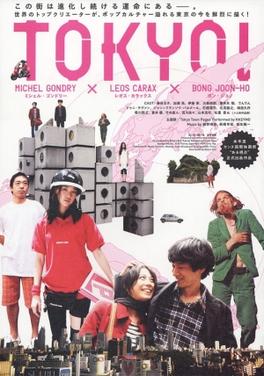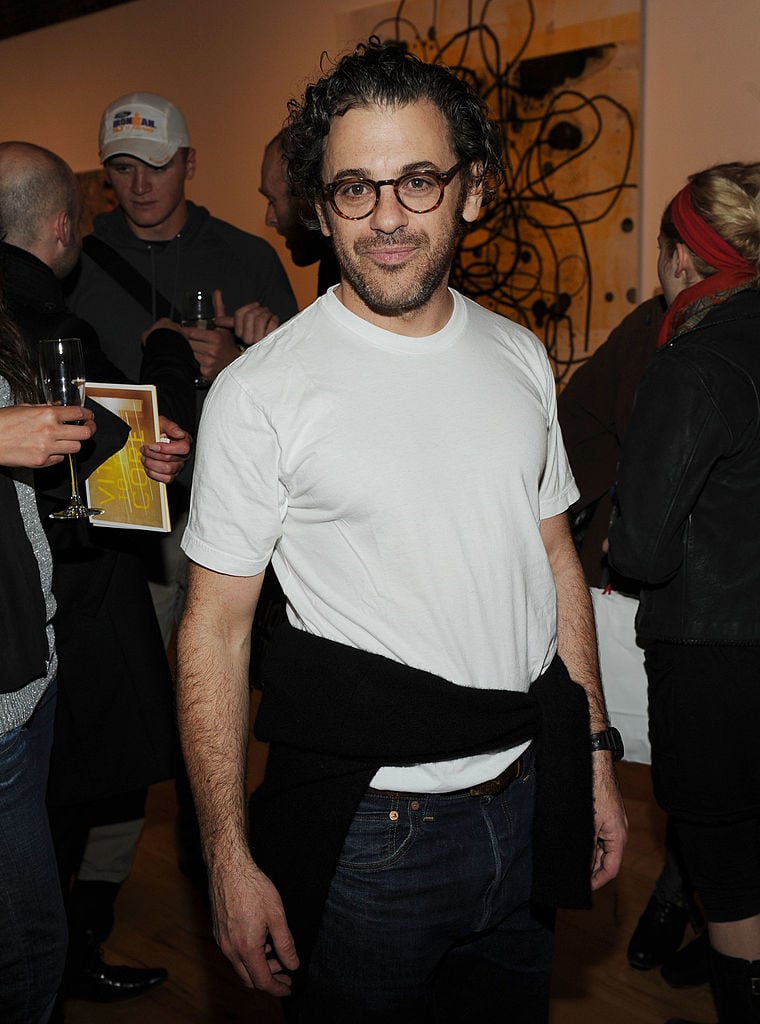Jul 05, 2016 Fans of his work may revel in the high-concept surrealism of director Michel Gondry’s filmography, while other audiences not attuned to his style may find it abundantly aimless and self-referential. Volume 3 of Palm Pictures' Directors Label series is The Work of Director Michel Gondry.And while perhaps the least known of the three directors in this collection, Gondry's set actually emerges.
- The Work Of Director Michel Gondry Isolate
- The Work Of Director Michel Gondry Iso Download
- The Work Of Director Michel Gondry Iso Full
In this essay, three movies from the French film director Michel Gondry are analysed, namely Be Kind, Rewind, Eternal Sunshine of the SpotlessMind and The Science of Sleep.
Gondry blends different techniques which he applies in his movies, in famous advertisements, as well as in music videos for artists such as Bjӧrk, Kylie Minogue, Daft Punk and The Chemical Brothers. Having been in the music industry himself as a video maker and drummer for the music band Oui Oui, he seems to promote the essence of music in some of his movies. Similarities in his three movies show that Gondry exhibits a music culture. To narrate his stories, Gondry uses mise-en-scene, animation, editing, sound and other techniques as well as multiform narratives. Even though the three movies analysed in this essay appear to follow classical Hollywood conventions, they leave space for doubt and for thought. Gondry achieves this by using space and time, but not in a linear, conventional way. The film director creates a film style of his own, mixing up different film techniques. Michel Gondry’s ideas seem fictional, but he interprets them in a realistic way in his movies, subtly adding a touch of surrealism in some sequences. The audience, to keep track of the narrative, should follow it attentively, making connections between events happening and linking sequences which sometimes do not follow each other in an orderly manner.
The narrative complexity of Eternal Sunshine of the Spotless Mind and The Science ofSleep implies the use of multiform narrative structures. Chris Dzialo, in “Puzzle Films: Complex Storytelling in Contemporary Cinema”, describes this narrative style as “frustrated time” narration where space and time are in opposition to each other. Jason Buel, from the Appalachian State University, argues that Michel Gondry leaps through space and through time. The French director defies the concept and variable of time. For example, In Eternal Sunshine of the Spotless Mind, the opening sequence appears not to be the beginning of the story as the movie unfolds. The dénouement of the three movies also leaves the audience in suspense, as the conflicts are not clearly resolved at the end of the movies. During the last-mentioned movie, as a disruption in the form of a cerebral trauma appears, the temporal control of the protagonist is affected. In The Science of Sleep, Stéphane builds a time-machine that can go back in time for a second. As he mixes his dreams with reality in the movie, the narrative shuffles and time, memory and dreams become tangled up. The protagonist, in a room made of crafty material and with cardboard video cameras, can even view his dreams in a diegesis before the audience can see it. Flashbacks of his distress are transformed and depicted visually to the audience, while it is clear that the audience has now entered the dream of the actor. Another aspect of a combination of dreams and reality is the somnambulism of Stéphane. As he mixes up his dreams with reality, the narrative shuffles and time, memory and dreams merge. Gondry’s movies also have a close relationship with the past. In order of their release, Eternal Sunshine of the Spotless Mind is an attempt to erase the past, The Science of Sleep involves introspections of the past in Stéphane’s dreams, and Be Kind, Rewind is a tribute to the past. Memory is a recurring theme in Gondry’s movies. In the three movies, respectively, a love story is troubled by memory, an inventor builds up memories in dreams, and a famous Jazz artist is commemorated. Lacuna Inc., in Eternal Sunshine of the Spotless Mind, is named after a memory loss problem called Lacunar amnesia.
The use of mise-en-scene serves the implicit narrative functions of Gondry’s movies. Clementine, who has blue hair but is named after an orange fruit, also has an orange jacket. – “I apply my personality in a paste.”
When saying this sentence to Joel in Eternal Sunshine of the Spotless Mind, costumes and hair colours are used to make her statement visual. Later in the movie, her hair colour changes, and this thus shows a personality shift. Gondry uses elements of mise-en-scene such as props, costumes and setting. The use of costume to identify some traits of the protagonists is present in Gondry’s movies. Like Clementine’s hairstyle and jacket have a relationship with her personality, Jerry’s dirty clothes in Be Kind, Rewind indicate the environment in which he lives. The way he dresses up changes as he gains fame and his outfits seem to be affected by his financial status. As he gets wealthier with his self-made movies, his costume changes. In The Science of Sleep, Stéphane wears suits and shirts throughout the whole movie. He portrays a clean, nerdy and respectful image, and at the same time that of an educated person. In the movie, his time-machine appears to be the prop he uses to show his love to Stephanie indirectly. To his eyes, accepting the object would be obviously accepting his gift of love. Creativity through the invention of objects also brings the two actors closer to each other. In Be Kind, Rewind, wastes from a depot are used as props to make Art, as well as video tapes representing a now lost era. All the junk objects are recycled as tools to make craft for movies. Settings such as the frozen lake are used to create a cold atmosphere in Eternal Sunshine of the Spotless mind, and in Be Kind, Rewind, the depot is an unusual setting. In his mise-en-scene, Gondry gives value to forgotten objects and even people. Fletcher, Mike, Jerry shifted from being unimportant citizens to popular militants of Art. The musician Fats Waller too is brought back to life through a diegetic movie. Props can also be linked to sound in Michel Gondry’s movies.
In a tragic sequence where Joel is crying in his car, he inserts an audio cassette in his music player and the music plays in diegesis. Similarly, the music Stephane plays on the piano when he comes up with the brilliant of idea of making an animated movie with Stephanie, is played in diegesis. The same pattern of diegetic sound applies when Jerry sings the Ghostbusters soundtrack. The protagonists of the three movies all play music or sing in the diegesis of Gondry’s movies. They all appear to appreciate and be connected to music in a way or another. This might be due to Gondry’s musical background. His French background also shows in The Science of Sleep, where both the French and English languages are spoken by the actors. At the start of the movie, the narrative is told in a non-diegetic voice, which is that of Stephane himself. Popular soundtracks like “Everybody’s gotta learn sometime” in Eternal Sunshine of the Spotless Mind appeal to our emotions and make us feel closer to Joel. The song was covered by Beck for the movie and was originally by The Korgis. Sound is a constituent of atmosphere in Michel Gondry’s movies. Mood music sets the spirit of specific moments. At other times, the volume is amplified as well as its violence and impact to become action music. The state of mind of different scenes can be associated with the music accompanying them in non-diegesis. Noises like the sounds of the toy horse’s hooves in The Science of Sleep or of Stephane’s inventions when they are operating are added to the movie through sound effects. Another example of added sound effects is the scene in Be Kind, Rewind where Jerry approaches the TV in the shop after having magnetised all the video tapes. Even the word ‘Rewind’ from the movie title has a relationship with music. The use of sound effects in animated parts of his movies is frequent too.
Gondry focuses on the artistic side of film-making in his three movies. In his interview with David Schwartz on May 9th of 2008, the Chief Curator of the “Museum of the Moving Image”, Gondry says that he makes his animation movements with his own hands before putting their frames together. Through editing, Gondry brings his crafted, lifeless objects to life. Stop-motion animation is featured in The Science of Sleep. Water being transformed into a flowing river of cellophane and cotton puffs becoming clouds are made through animation and create an effect of surrealism. Collage and montage are other techniques used by Michel Gondry and these add an artistic touch to some of his props or vivified objects. He even uses cardboard to create fake cars in Be Kind, Rewind, and to make moving buildings in The Science of Sleep. His movies can be seen as containing elements of science-fiction. The three of his movies involves advanced technology in a way. In Eternal Sunshine of the Spotless Mind, the technology used by Doctor Howard to erase or have a control on memory is similar to that from sci-fi movies. In The Science of Sleep, Stephane invents means of technology which are clearly surrealistic. Finally, in Be Kind, Rewind, when Jerry gets magnetised and gets out of the electric shock on his feet, the scene looks like a science-fiction scene. The robot from the blockbusters made by Jerry and Mike can also relate to sci-fi. In “Memory Matters of the Digital Age”, José van Dijck observes that Michel Gondry has a fictional approach to modern science. For example, the mind of Joel is transformed into a digitally changed structure, which is surrealistic in the way it is done. In his animations and in science-fiction sequences from his movies, Michel Gondry uses props to give an impression of realism too. In the book “Music, Sound and Multimedia: From the Live to the Virtual”, he is even compared to George Meliès, the French film director and father of special effects.
The criteria, according to David Bordwell, that make a movie eligible as an Art Film are realism, authorship and ambiguity. Michel Gondry adds surrealism to the realism of his movies, creating a sense of ambiguity. In movies like Eternal Sunshine of the Spotless Mind and The Science of Sleep, Gondry seems to follow classical narrative conventions in the implicit meaning of his movies, but there seems to be two narratives going on simultaneously. The flow of his movies is not logical, and dreamscapes are also involved. Once again, ambiguity can be detected. Michel Gondry has his own signature and diverse techniques as a director and his movies could be similar to those under the category of auteur cinema. In his own way, he includes in The Science of Sleep and Eternal Sunshine of the Spotless Mind all the conventions needed for a classical narrative, but at the same time uses techniques from Art Films. This might seem contradictory in a sense, but all the elements from both film styles appear in The Science of Sleep and Eternal Sunshine of the Spotless Mind. The French critic and theorist of cinema, Raymond Bellour, argues that the ideology of Hollywood is fulfilled by the romantic couples in the narratives. Be Kind, Rewind is less ambiguous than the two precedent movies in the sense that the narrative is not as complex. However, some scenes can still trigger the following question in the audience: “Is this realistic?”
The dénouements of his three movies also leave space for the audience to suppose, predict or assume, causing ambiguity once again.
Entering the world of Michel Gondry implies an understanding of his style and themes. Some of his movie-making techniques and themes can be repetitive or similar in his different movies. In some movies, time is twisted. In others, dreams and memories disrupt the rational course of reality. As the director of the 64th Cannes Festival Cinema Foundation in 2011, Michel Gondry states that “dreams make stories out of chaos”. By using the finest technology in the narratives of some of his movies, he creates an image of a futuristic world. However, by using hand-made crafts from unused objects or basic material too, he reminds the audience that human values lie in imagination and sense of creativity. The film director also won an Academy Award in 2005 for his original screenplay, Eternal Sunshine of the Spotless Mind which starred celebrities like Jim Carrey, Kate Winslet and Kirsten Dunst. After the release of Be Kind, Rewind, he wrote a book: “You’ll like this Film because you’re in it: the Be Kind, Rewind Protocol.” Gondry expresses his vision and ideas through music videos, writing, film-making inter alia and can simply be considered as a virtuoso in the field of originality and creativity. He even wrote and drew a comic book called “We Lost the War But Not the Battle”. The psychology and passion of Michel Gondry as he explores human emotions, ideology and fantasies, shows in his recurring themes and stylistic choices.
References:
- Jason Buel. (2010).Nonlinear time and narrative loops in the work of Michael Gondry.Available from: <http://honors.appstate.edu/academics/thesis-examples/56>. [27.05.2013.]

- Everybody’s Got to Learn Sometime, Beck 2004, cover track forEternal Sunshine of the Spotless Mind (Motion Picture). United States, Hollywood Records.
- In-text: (David Schwartz, 2008)


Bibliography: Gondry, M. (2008) A Pinewood Dialogue with Michel Gondry. [in person] Museum of the Moving Image, May 9, 2008.]
- A Pinewood Dialogue with Michel Gondry, ‘Michel Gondry interviewed by David Schwartz’ [Interview] (Museum of the Moving Image, May 9, 2008). Available from: <http://www.movingimagesource.us/files/dialogues/3/42929_programs_transcript_pdf_307.pdf >. [27. 05. 2013]
- José van Dijck. (2004). Memory Matters in the Digital Age.University of Amsterdam. 12 (3), 349.
- Sexton, Jamie (ed.). (2007). Music, Sound and Multimedia: From the Live to the Virtual. Edinburgh, Edinburgh University Press, pp.34.
- Bellour, Raymond. “To Alternate/To Narrate (on The Lonedale Operator).” Trans. Inge
Pruks, revised by Roxanne Lapidus. The Analysis of Film. Ed. Constance Penley.
Bloomington: Indiana UP, 2000.
- Gondry, Michel. (2008). You’ll like this movie because you’re in it: The Be Kind, Rewind Protocol. New York, PictureBox Books.
- Gondry, Michel. (2008) We Lost the War, but not the Battle.New York, PictureBox Books.
The Work Of Director Michel Gondry Isolate
Gondry's third documentary, 'Is The Man Who Is Tall Happy?', wants you to listen to Noam Chomsky discuss love, linguistics and perception; very undergrad, perhaps, but a long way from untethered froth. Mostly hand-drawn animation and a few real physical objects are looped into stop-motion back-and-forth, riffing on and against Chomsky's words rather than simply illustrating them. An early image—a man whose head is a Bolex 8mm camera like the director's own, projecting out images of Chomsky—presumably represents Gondry himself, meaning this is a conversation taking place in (or being beamed out of his) his head.
In Gondry's flamboyantly impressive 'Eternal Sunshine Of The Spotless Mind', a depressed/depressive male weeps in agony in the opening scene, the kickoff to a first act that's largely a sequential series of hard-to-sit-through end-of-relationship arguments; much of the film literally takes place in Jim Carrey's mind. In Gondry's next narrative feature 'The Science Of Sleep,' Gael Garcia Bernal weeps on a bed with a Smiths poster on the wall behind him and has to have Charlotte Gainsbourg explain how girls (specifically, her) don't like it when he spontaneously breaks down weeping. These two films feature the most continuous dream imagery and attendantly necessary technical trickery of Gondry's cinematic career to date, but their generative centers are depressive, barely functioning men, socially isolated sources of imagery.

The Work Of Director Michel Gondry Iso Download
Between 'Sunshine' and 'Science,' Gondry released 'Dave Chappelle's Block Party,' a concert movie that's a celebration of black community on both a neighborhood level (in Brooklyn's Clinton Hill) and in the music industry. De-centering the narrative focus from Chappelle to a more expansive group of not-equally-famous voices seems to have rewired Gondry's interests a bit.
The Work Of Director Michel Gondry Iso Full
'When I did 'Block Party,' it was a lot about community and celebration, and I didn't understand what they were celebrating, but I think I got at the end a sense of the idea that they were celebrating togetherness and celebration itself,' he said in a recent interview. 'And I'm coming from a very average background, like white suburb, [in] which you don't have a sense of community […] in day-to-day life, you didn't really feel the need for community, and then when I met Dave Chappelle and I met all these musicians, I realized how community was something important. And so that was my point of view, I wanted to understand why it was important.'